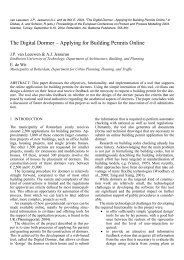ecppm 2002 - Jos P. van Leeuwen
ecppm 2002 - Jos P. van Leeuwen
ecppm 2002 - Jos P. van Leeuwen
Create successful ePaper yourself
Turn your PDF publications into a flip-book with our unique Google optimized e-Paper software.
gramme of the Design Systems group at the TU/e<br />
(de Vries et al, 2001).<br />
DesKs servers are envisioned to create a network<br />
where information is distributed and can be<br />
searched. The FBM framework supports a layered<br />
structure of information, allowing type definitions<br />
residing in one node of the network to reference type<br />
definitions in other nodes. This way, both new types<br />
and specialisations of previously published ones can<br />
be defined and published. This allows building<br />
product information for specific products to be created<br />
as specialisations of generic types that define<br />
the general properties of the products.<br />
It is our conclusion that a DesKs server could<br />
function as the “building product information gateway”<br />
to serve designers with product information<br />
that has been described by Augenbroe (1998).<br />
The DesKs technology supports both modelling<br />
of generic properties and searching for products that<br />
carry them. It also provides a programming interface<br />
to allow applications that handle IFC and PLIB data<br />
to become parts of a DesKs server. This makes the<br />
DesKs a plausible candidate for creating Augenbroe’s<br />
building product information gateway.<br />
3.1 Publishing product information using DesKs<br />
Using the DesKs technology to publish product information<br />
has a number of ad<strong>van</strong>tages for product<br />
suppliers. General ad<strong>van</strong>tages of online publications<br />
apply, such as the ability to provide the most up-todate<br />
information the moment it is requested. There is<br />
no delay in the process of publication and communication<br />
like there is with, for example, printed documentation.<br />
This ensures up-to-date information<br />
about the product itself, but also offers the possibility<br />
to include accurate information about availability,<br />
pricing, delivery times, logistics, conditions, etc.<br />
In addition to these ad<strong>van</strong>tages, DesKs provide<br />
the opportunity to have a direct interaction between<br />
suppliers and designers. Clients connect to the supplier<br />
and communicate design problems through<br />
formal models. Suppliers can provide design solutions<br />
that represent a product or a range of products.<br />
The solutions can include information for the particular<br />
design case, such as alternative design details,<br />
instructions for construction and assembly, casespecific<br />
information concerning costs, delivery, etc.<br />
The designer can use this information directly in his<br />
design model, and communicate it with his projectpartners.<br />
The DesKs technology is generally based<br />
on reference, thus the supplier data will remain<br />
within the supplier’s responsibility.<br />
4 THE FEATURE BASED MODELLING<br />
FRAMEWORK<br />
The following part is a brief explanation of some<br />
important aspects of the feature based modelling<br />
(FBM) framework; for an in-depth description, the<br />
reader is directed to other accounts of the FBM<br />
framework, in particular (<strong>van</strong> <strong>Leeuwen</strong> 1999).<br />
The FBM framework supports design by allowing<br />
the user to model both generic concepts and individuals.<br />
This makes the FBM framework a foundation<br />
for the kind of flexible tool that has been seen as<br />
necessary by many researchers, and which is also<br />
exemplified by other systems such as EDM2 (Eastman<br />
& Jeng 1999), the BAS·CAAD system (Ekholm<br />
& Fridqvist 1998) and the SOFA system (Galle<br />
1994).<br />
4.1 Property-oriented modelling<br />
The FBM framework is a property-oriented approach<br />
to modelling design information (<strong>van</strong> <strong>Leeuwen</strong><br />
et al 2001). Property-oriented information systems<br />
are characterised by their focus on the<br />
properties of the things to be modelled, e.g. ‘fire resistance’,<br />
‘mass’, or ‘colour’. This distinguishes<br />
these systems from class-oriented systems, which<br />
base modelling on classes of things, such as ‘wall’,<br />
‘window’, or ‘floor slab’. Property oriented systems,<br />
like FBM, allow objects under design to be specified<br />
incrementally, i.e. the designer can add specifications<br />
as they become known through the design<br />
process, since partially defined models are allowed.<br />
4.2 Complex features are defined through<br />
components<br />
In the FBM framework, generic concepts are modelled<br />
through feature types, and particular individuals<br />
through feature instances. Thus, a model consists<br />
of a collection of interrelated feature instances,<br />
which refer to generic concepts modelled as feature<br />
types.<br />
Features that carry higher-level meaning are created<br />
by combining lower-level ones in a structured<br />
manner. Complex features combine other features,<br />
both at the type level and at the instance level,<br />
through components that connect the complex feature<br />
to other features. Components are named, and<br />
can have one of three role types that define the relation<br />
between the higher-level feature and the lower<br />
one, i.e. decomposition, specification or association.<br />
Components thus define what roles the connected<br />
features play in the context of the complex feature.<br />
At the type level components additionally include<br />
cardinality information, which defines the lower and<br />
upper limits of the number of instances that, at the




